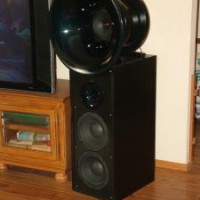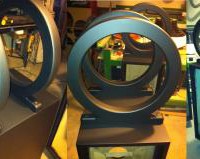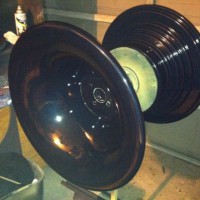Monaco
Designer: Gothover
Project Time: 20+ hours
Project Complexity: Hobbyist
Project Cost: Over $1000
Driver Selection
The heart of this project is the PS-220-8 coupled to my own design Monaco wood Tractrix horn. The woofers I chose for this project I have used many times before, tried and true performers, the Dayton Audio PA255-8 10″ Pro Woofer. The high frequency driver I chose is a new offering from Parts Express. The Dayton Audio D250P-8 1″ Polyimide Compression Horn Driver. This driver turned out to be a perfect match, high spl, incredible detail and smooth response.
Enclosure Design
For the enclosure design I used Harris Tech BassBox 6 Pro. I chose a ported enclosure for low bass extension. I also designed a circular horn mount for the midrange horn. Due to its similarities to the Greek symbol Omega, I so named the support “The Omega mount”. The midrange horn ‘Monaco’ used is my own design, a pure Tractrix expansion 23″ circular cross-section horn. The HF horn ‘ContracT’ used is also my own design, a hybrid horn, Conical at the throat and Tractrix at the mouth. For the horn designs I use a proprietary program written by: Albert J Klappenberger of ALK engineering, named Eliptrac.
Amplifier/Crossover Configuration
For simplicity, I chose a passive 3-way crossover offered by Dayton Audio, the Dayton Audio XO3W-375/3K 3-Way Speaker Crossover 375/3,000 Hz. Even though this crossover is a fine performer untouched, I chose to bypass the signal caps with Dayton .22 film and foil bypass caps and replace the 30uF electrolytic capacitor in the bandpass section with a Dayton Audio DMPC-33 33uF 250V Polypropylene Capacitor.
Enclosure Assembly
Assembly: I used an ‘EZ Router’ CNC router to notch and cut the stacked MDF horn. Next the horn is assebled, I used self aligning dowels to aid the assembly and glue the layers together with Gorilla wood glued. Then the horn is placed in a compression jig to minimize gaps in the layers while drying. Once the horn is dry it is mounted to a modified wood lathe used to shape and sand the horn. After the base sanding is done I apply a thin layer of filler followed by primer paint etc. The bass cabinet is a CNC cut conventional build rectangular ported enclosure with bracing.
Conclusion
I am particularly pleased with the outcome of the Monaco Project. The combination of drivers and horns makes for a listening experience like no other. The Monaco is a high sensitivity, high SPL speaker suited for a large range of listening environments, from a sublime 2 channel system to a full blown party speaker.
About The Designer
My name is Dave Harris, my Father and mentor Michael G Harris peaked my interest in audio when I was a child. Growing up in a home packed with speakers from Klipsch to Dahlquist, Ohm, and Magnepans, I knew audio would alway be a big part of my future. Although my hobbies shift back an fourth constantly I always manage to return to audio, and often with a new skill set that I can apply to my projects. My most recent modeling modeling hobby got me interested in CNC machining which made my stacked horn building technique possible. Fortunately my understanding Wife Candee that is also a hobbyist and understands the need to create.





+ There are no comments
Add yours